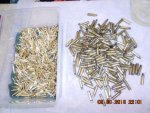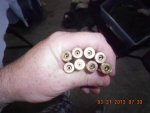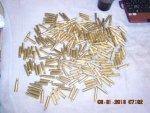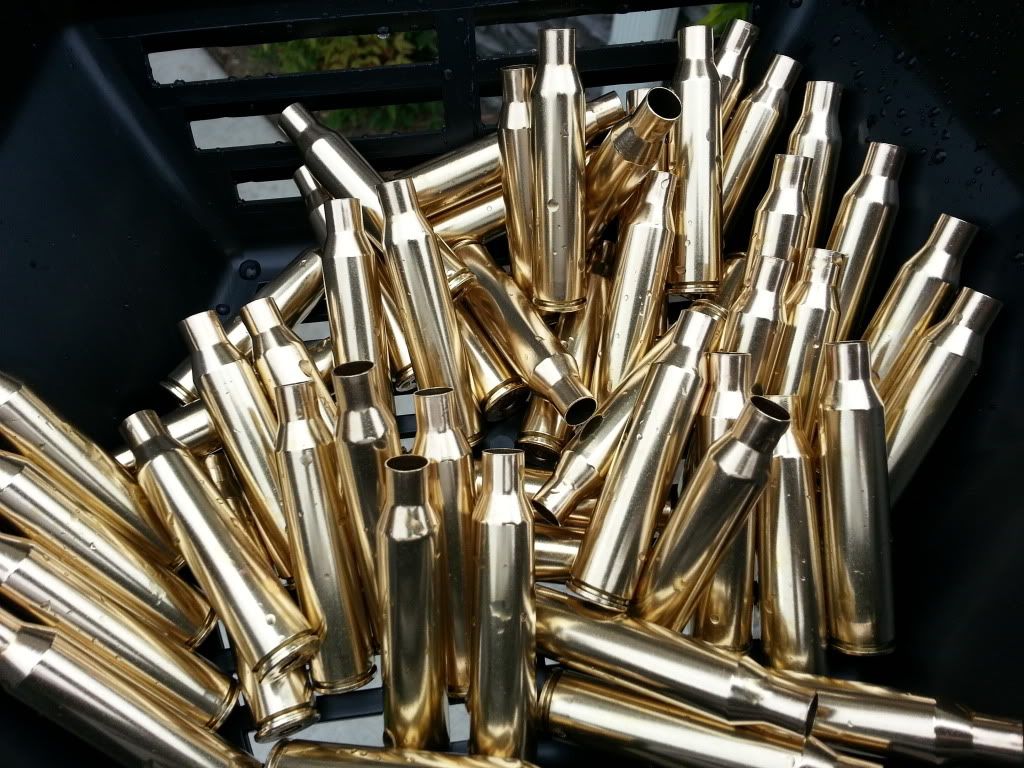Join the Hide community
Get access to live stream, lessons, the post exchange, and chat with other snipers.
Register
Download Gravity Ballistics
Get help to accurately calculate and scope your sniper rifle using real shooting data.

Install the app
How to install the app on iOS
Follow along with the video below to see how to install our site as a web app on your home screen.
Note: This feature may not be available in some browsers.
You are using an out of date browser. It may not display this or other websites correctly.
You should upgrade or use an alternative browser.
You should upgrade or use an alternative browser.
Stainless Steel Media Testimonials
- Thread starter Suasponte
- Start date
I ordered the STM pkg 3 weeks ago,it arrived unpacked it and put it together looks great but there was no ss media in the box.i called STM and they sent it out right away.thx to Cory and Trevor for getting the media out right away.i no things can get over looked but these guy dealt with it,GREAT SERVICE thanks.
Got my package from STM this past week. Run a batch of 300BLK through it after decapping brass and then again for a rinse after sizing. It is all that and then some. STM delivered as promised, damn good outfit!
Hi all, what are most of you using to separate the stainless pins from the brass when complete? I see that STM has a entire kit with a rotary media separator. I wonder how STMs separator works or is there something more efficient being used?
Lastly, what about drying the brass?
Thank you all in advance! Dave
Lastly, what about drying the brass?
Thank you all in advance! Dave
The guy that gave me the first mold just brought 3 more that need a tumbling.
Should be done them Monday sometime.
The water in the drum this morning looked like chicken broth. And no I didn't taste it.
Should be done them Monday sometime.
The water in the drum this morning looked like chicken broth. And no I didn't taste it.
I had a fun time drying about 100 .223 cases last night. After separating and rinsing them, I put them into one of my wife's baking tins and tossed them in the oven at 180 degrees. Unfortunately, after putting everything away I realized two things: 1.) whoops, that's 180 Celsius! 2.) shit! putting everything away took longer than I thought. So they were in a pre-heated oven at 356 Fahrenheit for about 6 minutes and came out HOT! My initial fear was that I may have annealed the case head, essentially ruining the brass. They didn't come out discolored like when I anneal the necks and 6 minutes isn't that long, but that is still pretty hot and .223 anneals pretty quickly. Needless to say they were plenty dry.
So what do you think? Toss 'em or not worry?
So what do you think? Toss 'em or not worry?
I would shoot them.
There are several temperatures at which brass is affected. Also, the time the brass remains at a given temperature will have an effect. Brass which has been "work hardened" (sometimes referred to as "cold worked") is unaffected by temperatures (Fahrenheit) up to 482 degrees (F) regardless of the time it is left at this temperature. At about 495 degrees (F) some changes in grain structure begins to occur, although the brass remains about as hard as before--it would take a laboratory analysis to see the changes that take place at this temperature.
If cases are heated to about 600 degrees (F) for one hour, they will be thoroughly annealed--head and body included. That is, they will be ruined. (For a temperature comparison, pure lead melts at 621.3 degrees F).
Off 6mmbr
There are several temperatures at which brass is affected. Also, the time the brass remains at a given temperature will have an effect. Brass which has been "work hardened" (sometimes referred to as "cold worked") is unaffected by temperatures (Fahrenheit) up to 482 degrees (F) regardless of the time it is left at this temperature. At about 495 degrees (F) some changes in grain structure begins to occur, although the brass remains about as hard as before--it would take a laboratory analysis to see the changes that take place at this temperature.
If cases are heated to about 600 degrees (F) for one hour, they will be thoroughly annealed--head and body included. That is, they will be ruined. (For a temperature comparison, pure lead melts at 621.3 degrees F).
Off 6mmbr
I can honestly say, that my ability to make hits on the 1000 and 1200yd steel plates, definitely improved after I began cleaning with SS.
I had a fun time drying about 100 .223 cases last night. After separating and rinsing them, I put them into one of my wife's baking tins and tossed them in the oven at 180 degrees. Unfortunately, after putting everything away I realized two things: 1.) whoops, that's 180 Celsius! 2.) shit! putting everything away took longer than I thought. So they were in a pre-heated oven at 356 Fahrenheit for about 6 minutes and came out HOT! My initial fear was that I may have annealed the case head, essentially ruining the brass. They didn't come out discolored like when I anneal the necks and 6 minutes isn't that long, but that is still pretty hot and .223 anneals pretty quickly. Needless to say they were plenty dry.
So what do you think? Toss 'em or not worry?
And this is why I say you should not dry your brass in a oven. It is too easy to over heat your brass.
Find a old food dehydrator, or make one. There are many versions that guys have shown in this thread.
When in doubt of any process that you have done in your reloading steps (even drying your brass), I would
not risk firing that brass. 100 rounds versus possible bodily injury or loss of eye sight is not worth it.
DO NOT let the cost of components be a factor in the safety of what your loading and shooting.]
It is really easy for someone that will not be pulling the trigger on that rifle just to tell you
"I would shoot them". If there is any doubt in your mind (And it appears there is cause you asked what
we think) toss them and be at peace in your mind when you pull that trigger.
Just my 2 cents.
Terry
Last edited:
I can honestly say, that my ability to make hits on the 1000 and 1200yd steel plates, definitely improved after I began cleaning with SS.
Yeah, you missed out yesterday! 75% hit rate for me at 1160yd on a 16"x16" plate with the 243 and 105gr Noslers.
15 out 20 shots fired on target. Load was 43gr RL22, 105gr Nosler, Wolf LR primer, Hornady Match Brass, velocity at 2850fps.
Come up was 38.5moa.
Trucks in the first photo are 260yds back from where the picture was taken. Target pit was 160yd from the plate swinger.
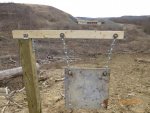
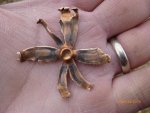
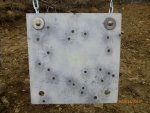
Last edited:
This is the thread that convinced me to buy a Thumlers and SS media pack over a year ago. By far one of the best investments in my reloading setup. I love picking up the nastiest range brass, cleaning it, and find out that most of it is useable. Also, not to mention my wrist no longer hurts from cleaning primer pockets 
cleaning my first batch now, first time, waiting for them to be done. will report back,have about 4k 223, 2k 308, 2k 45 ready to go through this machine.
Alright! Finally got my Thumler and ran it on some 45 and 223 so far! I think I realized why we all love this method so much, its when you pour out that nasty black water and see shiny gold and silver in the tub, its like panning for precious metals.
My musings so far:
- The steel pins can "float" (not really float, but ride surface tension) for a little bit when pouring, I've lost 2 or 3 already due to this phenomenon
- about 3.5 hours was needed to get the primer pockets more towards 95% clean
- I thought I could run a few loads and put off painting the inside of the Thumler drum for a few days. Well, those pins don't rust but the drum sure does! So now its painted.
- I weighed the load precisely that went into the drum, and the motor still got pretty warm, so I pointed a fan on it and that helped a lot, otherwise it made the room smell a little
- Grease was helpful on the plastic bearings that the drum rotates on, it makes them run much cooler, I also thought it would be a good idea to oil the motor
- I use a lee powder dipper that is the same capacity as a 9mm case for the lemi shine, which is so far the only thing I've used those lee dippers for
- I have had 3 or 4 45acp cases have pins stuck in the flash hole, this is out of maybe 700 cases, and threw out those pins. I got the pins from midway
And oh yea, Wichita State (my alma mater) to the Final Four baby!!! Go Shocks!
My musings so far:
- The steel pins can "float" (not really float, but ride surface tension) for a little bit when pouring, I've lost 2 or 3 already due to this phenomenon
- about 3.5 hours was needed to get the primer pockets more towards 95% clean
- I thought I could run a few loads and put off painting the inside of the Thumler drum for a few days. Well, those pins don't rust but the drum sure does! So now its painted.
- I weighed the load precisely that went into the drum, and the motor still got pretty warm, so I pointed a fan on it and that helped a lot, otherwise it made the room smell a little
- Grease was helpful on the plastic bearings that the drum rotates on, it makes them run much cooler, I also thought it would be a good idea to oil the motor
- I use a lee powder dipper that is the same capacity as a 9mm case for the lemi shine, which is so far the only thing I've used those lee dippers for
- I have had 3 or 4 45acp cases have pins stuck in the flash hole, this is out of maybe 700 cases, and threw out those pins. I got the pins from midway
And oh yea, Wichita State (my alma mater) to the Final Four baby!!! Go Shocks!
Hi all, what are most of you using to separate the stainless pins from the brass when complete? I see that STM has a entire kit with a rotary media separator. I wonder how STMs separator works or is there something more efficient being used?
Lastly, what about drying the brass?
Thank you all in advance! Dave
I think the rotary separator they sell is about as good as it's going to get. I've had a STM set for maybe 8 months and it's awesome, but getting all the pins out of the brass is a chore. I've taken to depriming rifle cases before tumbling as I've had pins stick in the flash holes making depriming nearly impossible until I take the case out of the press and tap the hell out of it to get the pin out. That said, I've pulled 2 or 3 pins out of flash holes as they can get stuck in them too when I tumble the deprimed cases. Occasionally I'll start to crank down the arm and I know there's a pin stuck inside a 9mm case (or .45 acp, or 357 SIG) and I've developed a sort of algorithm for pulling the uncrimped round from station 5, then rotating the shell plate to remove one case at a time, removing the pin, then feeding the cases back into the press in the right order - I use a Dillon XL650 press. But compared to the the dust and problems with corn cob or walnut, STM is still worth the learning curve. Wish I'd known about it years ago.
After rinsing the brass I pour it all out on a big green micro fiber towel we got for bathing our dogs. This thing soaks up water like crazy. Then I pour the brass into a stainless colander, and put it into the oven at its lowest setting (175 F) and turn off the oven. Couple of hours later I've got clean, dry, bright and shiny brass and, in the words of the guy who introduced me to reloading many decades ago, "shiny is good."
Some pictures, first is some cleaned 223 next to uncleaned 308, second is some cleaned 308 primer pockets from the cases in the first pic, third is cleaned 308s from first pic. These cases are jewelery quality cleaned, 1 tbs lemon shine 1 tbs dawn, add water and roll for 3 hours. After I sell my 2 rcbs vibratory tumblers I urge everyone to switch over to this system. In the mean time I am checking with the metallurgists at my research and engineering division on the effect of work hardening from this method, cursory checks with my young engineers tells me its not problem unless done under high heat and over a long time frame, the brass will be shot out by then. Will report back.
Attachments
Last edited:
I know I have said this a million times but I still get giddy when I open up my
tumbler and see my nice clean brass. Been doing it for well on 6 years now
and have to say that this is the only cleaning method I use. I do have a vibratory
tumbler that I use tube clean case lube off or touch up case when the other two model
"B"'s are going.
Terry (Happy Easter!!) & Happy 8th B-Day to my Son
tumbler and see my nice clean brass. Been doing it for well on 6 years now
and have to say that this is the only cleaning method I use. I do have a vibratory
tumbler that I use tube clean case lube off or touch up case when the other two model
"B"'s are going.
Terry (Happy Easter!!) & Happy 8th B-Day to my Son
Last edited:
Hi all, what are most of you using to separate the stainless pins from the brass when complete? I see that STM has a entire kit with a rotary media separator. I wonder how STMs separator works or is there something more efficient being used?
Lastly, what about drying the brass?
Thank you all in advance! Dave
I am using a media separator similar to STM's and it does just fine. As far as drying, I lay the brass out on a towel and lay it under a ceiling fan and they dry just fine. I am new to reloading so I am just stating to figure out a regimen. Leaving the brass to dry while I take of other things works out for me.
I will try the grease on the bearings this weekend to stop some of the squeaking I am hearing on my Thumbler. I put 150 300BLK cases in yesterday in it squealed like a pig. The card they sent said it would handle ~160-180 .223 cases, but I may roll that back a few for the weight.
Its not really a bearing it is more of a sleeve on the axel, just put some 3 in 1 oil on the shaft and slide the sleeve around, just a couple drops will do. remember the sleeve is plastic/rubber so don't put straight oil on it, use 3-1 or another rubber friendly lube.
I am putting 300 to 400 of 223 cases in the drum and running 3 hours.
I am putting 300 to 400 of 223 cases in the drum and running 3 hours.
Before and after shots of a piece of brass found out in the desert. It was out there for many years as I found it buried and just happen to see it sticking out a tiny bit when I was picking up another piece of brass. Heck I thought it was steel and almost through it in my steel scrap bucket. That is the same piece of brass standing up after 5 hours of tumbling with SS media (only RP headstamp in the lot so I know it is the same piece). I normally only tumble for 2-2.5 hours and the brass looks that good (for my brass that hasn't been sitting out forever) but since this lot of 30-06 (308's in the background on the screen) had this case in it I let it go longer. It has been out there for a few years before I found it but it certainly looks better than new now. My brass is drying in the sun on a window expandable screen after I town dry it the best I can. I found that folding the town in half and tumbling the brass back and forth from one end to the other helps get water out of the inside of the cases really well. I only have the SS pins for 2 drums and the 3rd currently leaks so I need to find replacement liner for it (pretty much all 3 should be replaced but heck if it holds the water I just tumble). My mixture is 2 quick squirts of Dawn, 1 9mm case of Lemishine, and water to 1" short of the top of the drum.



[video]http://s817.photobucket.com/user/SmokinAce1/media/Random%20Stuff%20for%20SH/VID00000-20111126-1745_zps521f0101.mp4.html[/video]



[video]http://s817.photobucket.com/user/SmokinAce1/media/Random%20Stuff%20for%20SH/VID00000-20111126-1745_zps521f0101.mp4.html[/video]
Last edited:
After rinsing the brass I pour it all out on a big green micro fiber towel we got for bathing our dogs.
Similarly, I used a cheap vegetable colander (don't tell my wife) and a sheer privacy drape from one of the windows (think cheese cloth; and don't tell my wife
Seriously, I did not use the existing drapery, but did use a cheap (read $5) sheer privacy drape from Home Depot to line the colander/strainer....
I just put my two media tumblers up on craigs list just to get them out of the garage. Unbelievable machine, man o man.
This thing is unbelievable, I will be selling my two rcbs vibrator machines.
Keep one.
Reason being, I've found that when the brass gets too clean on small pistol cases (.45 acp, 9mm PB) they will STICK when lowering the handle on a progressive loader (Dillon in this case). I've polished the hell out of the powder dropl/belling tubes and rather than spray lube (like the lanolin/alcohol mix or silicone) I throw the cases into a tumbler full of corn cob tumbling media with a tablespoonful of mica powder (all OSHA-approved pulmonary protection guidelines are followed, of course). This adds JUST enough mica to make resizing/release from the powder tube a whole lot easier.
Of course, and always, YMMV.
size, trim and debur after.
Only prep is to deprime and decrimp (if needed)...
Same here and depending on the case if I use lube to size I re-tumble with dawn and water (use a homemade case lube so soap takes it off really well) after I do the the first tumble then prep.
Same here and depending on the case if I use lube to size I re-tumble with dawn and water (use a homemade case lube so soap takes it off really well) after I do the the first tumble then prep.
I'm new to stainless media tumbling, and haven't done any lubed resizing since I got my tumbler a week ago. Are you tumbling them without the steel pins too? And is this home made lube Lanolin based? I've heard stories that Lanolin can be hard to take off. Also, do you use hot, warm or cold water for the de-lube cleaning cycle?
I'm new to stainless media tumbling, and haven't done any lubed resizing since I got my tumbler a week ago. Are you tumbling them without the steel pins too? And is this home made lube Lanolin based? I've heard stories that Lanolin can be hard to take off. Also, do you use hot, warm or cold water for the de-lube cleaning cycle?
I do not always use the pins in my cleaning cycle. I have 3 drums and only 2 have SS so if I need to clean some brass the sized brass goes in a drum with water and dawn. I do put some more soap in then I do when I clean so maybe 2x more. I only tumble that for 30 min or so and I have yet to have my brass have lube on it still. I also don't go crazy with the case lube like some guys I have seen. I know what is enough to size my brass without wasting or taking the chance of a stuck case. The solution I use is lanolin based and it can be tuff to get off it you go crazy with it or if your solutions (usually alcohol and lanolin) because off balance and the alcohol has evaporated.
I size, tumble and reload, no issue on 1000 rounds of 308 just in my spare time this week, need small rifle primers, only have 1 k left.
If I am not concerned about gtting the Primer pockets clean I will tumble just the brass
with dish soap and Lemshine for a 2-3 hours.
They come out clean enough for me, but you still cannot beat doing it with the pins.
I usally do it when I don't fell like having to seperate the pins from the brass.
Terry
with dish soap and Lemshine for a 2-3 hours.
They come out clean enough for me, but you still cannot beat doing it with the pins.
I usally do it when I don't fell like having to seperate the pins from the brass.
Terry
http://i434.photobucket.com/albums/...3-BDF2-B0D7C2AE692D-3425-000002778BC3BF6B.jpg
I figured I should share some results since you all have been so helpful answering my questions! I know, I know, they aren't great quality iPhone pics, which is one of my pet peaves, sorry!
That's a little pile of 50bmg. It was as nasty looking as any m33 ball could be. I don't even have a 50 press, but I hand deprimed them with a pin punch anyway! That took 3 batches, and no matter how many or how few I put in the 50 comes out with a bit of a burnished look. I still like it though, you probably can't tell from that pic though.
I've ran many loads throughout the day while I'm studying. About 2k 9mm, 1.5k 223, 1k .38spec, <1k 45, and 500 308 so far!
I have used cold water wash and rinse and lay out on a towel to dry for a day or two.
What I have been doing is for dirty brass I'll throw it in with soap and lemi and no pins, not deprimed and run it for an hour. Then after rinsing and letting it dry ill lube them up (lanolin spray in plast bag) and size them. So no extra deprime step, and then i'll run them 3-4hr to get the lube off, give them a better polish and get the primer pockets clean.
I use a little extra soap for the de-lube process. So far I can't detect any lube left over. I think I may keep doing things this way.
Since the brass is sized (I use a Lyman m expander to coax the neck back into shape if it needs it or not) I put a lee decaping die in station 1 as a safety against stick pins. However, being OCD trait, I check all the flash holes before taking them off the drying towel. For around 800 9mm just today I found 8 with pins in them.
So far, I'm loving this!
I figured I should share some results since you all have been so helpful answering my questions! I know, I know, they aren't great quality iPhone pics, which is one of my pet peaves, sorry!
That's a little pile of 50bmg. It was as nasty looking as any m33 ball could be. I don't even have a 50 press, but I hand deprimed them with a pin punch anyway! That took 3 batches, and no matter how many or how few I put in the 50 comes out with a bit of a burnished look. I still like it though, you probably can't tell from that pic though.
I've ran many loads throughout the day while I'm studying. About 2k 9mm, 1.5k 223, 1k .38spec, <1k 45, and 500 308 so far!
I have used cold water wash and rinse and lay out on a towel to dry for a day or two.
What I have been doing is for dirty brass I'll throw it in with soap and lemi and no pins, not deprimed and run it for an hour. Then after rinsing and letting it dry ill lube them up (lanolin spray in plast bag) and size them. So no extra deprime step, and then i'll run them 3-4hr to get the lube off, give them a better polish and get the primer pockets clean.
I use a little extra soap for the de-lube process. So far I can't detect any lube left over. I think I may keep doing things this way.
Since the brass is sized (I use a Lyman m expander to coax the neck back into shape if it needs it or not) I put a lee decaping die in station 1 as a safety against stick pins. However, being OCD trait, I check all the flash holes before taking them off the drying towel. For around 800 9mm just today I found 8 with pins in them.
So far, I'm loving this!
Last edited:
Watch that the media length isn't near the caliber being tumbled or sometimes they will get lodged in the neck. When I set my cleaned brass up for trimming I can see down the neck and actually identify case seperation without useing the old paperclip feel test.
My experience so far using SS media in Thumler's Model B
I received my Stainless Steel Reloading kit from STM Wednesday 04-24.
Assembly was very quick and easy since I had previously watched a You Tube video of someone doing the same thing.
I oiled the plastic bearings with some 3&1 oil prior to use.
I added water and 5 pumps of Dawn dish washing liquid from a recycled hand soap bottle.
I ran the system for about 5 hours without brass to clean off any manufacturing residue on the rubber or pins.
The water came out very black and rather sudsy.
I've since reduced the pumps of Dawn to 4 and that works perfectly, suds but not excessive.
So far I've cleaned about 1.5K 9mm range brass.
Excellent results!
System is surprisingly quiet when running.
My first batch I actually counted out 230 9mm brass so I would have a quick reference for future loads of 9mm.
This brass had already been "cleaned" in my Midway 1292 with corncob media, then resized and deprimed.
Since it was already rather clean, I tried only a 2 hour run in the Thumler's Model B with the SS pin media.
The brass came out looking like new, except there was still quite a bit of residue in the primer pockets of several cases.
3.5 to 4 hours seems to do a great job.
The water from this "clean" brass was very dirty.
I did have 7 of the 230 original cases with 2 SS pins jammed together in the flash hole.
1 case had a SS pin stuck crossways inside the empty primer pocket.
I've since run about 1250 more 9mm brass through with no more stuck pins in the flash holes.
Then I realized, the brass with the stuck pins were all PMC head stamped. ( I mostly separate the brass by head stamp)
Other brands did not have that problem. In fact, one load was my "misc" head stamp batch.
It contained various small quantities of head stamps from Hornady, Blazer, S&B, S&W, CBC, Geco, LY, Impact3D, IMI, Speer, PARA.
None had stuck pins.
Now curious, I found that a #48 drill bit would easily pass through the PMC case flash holes that had stuck pins, but would not pass or fit tightly into the flash holes of several of the other brands.

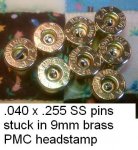
I checked a couple of the SS pins = .040 dia x .255 long
For separating the dirty water and SS media from the 9mm brass I do the following.
Remove the lid from the Model B and decant the dirty water into my utility sink.
Pour slowly so you don't loose any SS pins.
When most of the water is gone, I dump the remaining water, brass and SS media into a Frankford Arsenal Standard Media Separator that is sitting in a white 5 gallon bucket in the utility sink.
I will add a little clean water and rinse the tumbler out dumping it into the media separator.
Next, I pull out the sink sprayer and spray warm water over the brass and SS media while stirring it around in the media separator with my hand.
The SS pins quickly fall into the bucket and vigorously stirring while spraying the brass seems to knock the pins out easily.
This seems to take about as much time as separating 9mm brass from corn cob media in the same media separator.
Once the brass appears to have no more SS pins left, I dump the brass from the media separator into a bowl shaped coarse wire food strainer held over the bucket, just in case any more pins fall out.
Then, working over the bucket, I toss the brass in the wire food strainer a few times in a quick "scooping" motion so the brass flips over and most of the remaining water and any remaining SS pins fall out into the bucket.
So far I have not noticed any SS pins falling out at this point.
Next, I dump the damp brass onto a large towel to air dry.
I take the media separator out of the bucket, checking for any remaining SS pins.
Then I decant the water off of the SS pins.
The white bucket makes it easy to see the pins while carefully pouring off the water.
I will rinse the pins once or twice if needed, by adding warm water and swirling the SS pins around in the bucket.
The clean SS pins then get dumped back into the tumbler for the next batch of brass.
4 squirts of Dawn, a dash of Lemi Shine, a gallon of water, tumble for 4 hours for "new" brass.
I plan on making a brass dryer from an old desktop computer tower case, sort of like the ammo box on page 1 of this thread, only laid on its side.
I hope this helps someone with some ideas or decisions if they are considering this system.
The more I use it, the more I like it.
I received my Stainless Steel Reloading kit from STM Wednesday 04-24.
Assembly was very quick and easy since I had previously watched a You Tube video of someone doing the same thing.
I oiled the plastic bearings with some 3&1 oil prior to use.
I added water and 5 pumps of Dawn dish washing liquid from a recycled hand soap bottle.
I ran the system for about 5 hours without brass to clean off any manufacturing residue on the rubber or pins.
The water came out very black and rather sudsy.
I've since reduced the pumps of Dawn to 4 and that works perfectly, suds but not excessive.
So far I've cleaned about 1.5K 9mm range brass.
Excellent results!
System is surprisingly quiet when running.
My first batch I actually counted out 230 9mm brass so I would have a quick reference for future loads of 9mm.
This brass had already been "cleaned" in my Midway 1292 with corncob media, then resized and deprimed.
Since it was already rather clean, I tried only a 2 hour run in the Thumler's Model B with the SS pin media.
The brass came out looking like new, except there was still quite a bit of residue in the primer pockets of several cases.
3.5 to 4 hours seems to do a great job.
The water from this "clean" brass was very dirty.
I did have 7 of the 230 original cases with 2 SS pins jammed together in the flash hole.
1 case had a SS pin stuck crossways inside the empty primer pocket.
I've since run about 1250 more 9mm brass through with no more stuck pins in the flash holes.
Then I realized, the brass with the stuck pins were all PMC head stamped. ( I mostly separate the brass by head stamp)
Other brands did not have that problem. In fact, one load was my "misc" head stamp batch.
It contained various small quantities of head stamps from Hornady, Blazer, S&B, S&W, CBC, Geco, LY, Impact3D, IMI, Speer, PARA.
None had stuck pins.
Now curious, I found that a #48 drill bit would easily pass through the PMC case flash holes that had stuck pins, but would not pass or fit tightly into the flash holes of several of the other brands.


I checked a couple of the SS pins = .040 dia x .255 long
For separating the dirty water and SS media from the 9mm brass I do the following.
Remove the lid from the Model B and decant the dirty water into my utility sink.
Pour slowly so you don't loose any SS pins.
When most of the water is gone, I dump the remaining water, brass and SS media into a Frankford Arsenal Standard Media Separator that is sitting in a white 5 gallon bucket in the utility sink.
I will add a little clean water and rinse the tumbler out dumping it into the media separator.
Next, I pull out the sink sprayer and spray warm water over the brass and SS media while stirring it around in the media separator with my hand.
The SS pins quickly fall into the bucket and vigorously stirring while spraying the brass seems to knock the pins out easily.
This seems to take about as much time as separating 9mm brass from corn cob media in the same media separator.
Once the brass appears to have no more SS pins left, I dump the brass from the media separator into a bowl shaped coarse wire food strainer held over the bucket, just in case any more pins fall out.
Then, working over the bucket, I toss the brass in the wire food strainer a few times in a quick "scooping" motion so the brass flips over and most of the remaining water and any remaining SS pins fall out into the bucket.
So far I have not noticed any SS pins falling out at this point.
Next, I dump the damp brass onto a large towel to air dry.
I take the media separator out of the bucket, checking for any remaining SS pins.
Then I decant the water off of the SS pins.
The white bucket makes it easy to see the pins while carefully pouring off the water.
I will rinse the pins once or twice if needed, by adding warm water and swirling the SS pins around in the bucket.
The clean SS pins then get dumped back into the tumbler for the next batch of brass.
4 squirts of Dawn, a dash of Lemi Shine, a gallon of water, tumble for 4 hours for "new" brass.
I plan on making a brass dryer from an old desktop computer tower case, sort of like the ammo box on page 1 of this thread, only laid on its side.
I hope this helps someone with some ideas or decisions if they are considering this system.
The more I use it, the more I like it.
I am going to buy a magnet to throw in with the brass for when I do final strain and shake. I used a small one and it did pick up some hider pins, will get a larger more powerful one.
Dnalsi, are you using any dishwasher detergent in the process?
Dnalsi, are you using any dishwasher detergent in the process?
ArmyJerry,
I use just the regular liquid Dawn for hand washing dishes.

...because it "helps save wildlife"....
until I pull the trigger
A magnet might be a good idea.
I have some of those super power magnets pulled from inside an old computer hard drive.
I could lay it in the sink to "grab" any pins that escape and might be headed for the drain.
I use just the regular liquid Dawn for hand washing dishes.

...because it "helps save wildlife"....
until I pull the trigger
A magnet might be a good idea.
I have some of those super power magnets pulled from inside an old computer hard drive.
I could lay it in the sink to "grab" any pins that escape and might be headed for the drain.
Last edited:
I just changed loads in my Thumler Model B.
I set up the stop watch on my phone and timed myself to see how long it actually takes me to go from "tumbling to tumbling".
That is:
Taking the finished load of clean tumbled brass off the base, rinsing, separating brass from media and laying damp brass out to dry.
Loading another batch of dirty brass, with soap and Lemi shine, closing up the lid and placing the tumbler back on the base.
Total time 8 min 1 second.
I was purposely not trying to hurry, and I did spend some extra time picking up a couple of pins that had clung to the media separator and fell in the sink.
On a side note:
This cleaned brass was all Win head stamped 9mm.
I found 7 cases with 2 pins stuck in the flash hole.
This inspection process was NOT included in the 8 minutes as I did it later.
It sure is pretty...
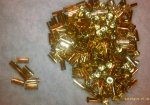
Edited to add:
I just did another batch/load change. 8 minutes on the nose
At least I'm consistent.
This was all RP brass. Not one brass with stuck pins in the flash holes.
I set up the stop watch on my phone and timed myself to see how long it actually takes me to go from "tumbling to tumbling".
That is:
Taking the finished load of clean tumbled brass off the base, rinsing, separating brass from media and laying damp brass out to dry.
Loading another batch of dirty brass, with soap and Lemi shine, closing up the lid and placing the tumbler back on the base.
Total time 8 min 1 second.
I was purposely not trying to hurry, and I did spend some extra time picking up a couple of pins that had clung to the media separator and fell in the sink.
On a side note:
This cleaned brass was all Win head stamped 9mm.
I found 7 cases with 2 pins stuck in the flash hole.
This inspection process was NOT included in the 8 minutes as I did it later.
It sure is pretty...

Edited to add:
I just did another batch/load change. 8 minutes on the nose
At least I'm consistent.
This was all RP brass. Not one brass with stuck pins in the flash holes.
Last edited:
Ran my fist batch this afternoon, used a shootin partner's thumbler and media given to me by a friend. On my first 60ct of 300WM I filled with hot water, a squirt of dawn and a teaspoon of lemishine. After 3 hours I drained off the purple koolaid looking water saving all the media, then filled it again with hot water for an hour rinse cycle. Drained half the water off and set a pail of cold water beside the thumbler, shaking out all the media from inside the case, while submerged in the half full thumbler (did not loose one piece of media) then did a rinse in the cold water pail one case at a time. Had a towel set out for drying so when the case came out of the pail rinse it was still hot enough that with a roll on the towel my fingerprint moisture would evaporate quickly, I then shook out all the water from inside the cases and there was not any additional dry time.
Alright all you Stainless Media Experts, I need some help. I'm just about going crazy over here!
For the life of me, I can't get the insides of my .223 cases bright and shiny anymore. There's no carbon left, but for how dark the cases are on the inside, I might as well have just run these through my vibratory.... I'm pretty sure it's just very tarnished on the inside. The outside looks great.
I've tried everything I can think of, including:
-Altering Lemishine content from 1/8 teaspoon to 1.5 teaspoon
-Cold, warm, and hot water
-Clean pins by running with just soap and Lemishine
-Weighed my remaining pins since I'm a bit clumsy with pin collection (4lbs, 14oz left)
My normal solution is 1/4 teaspoon Lemishine (.40S&W case full), 1.5 tablespoons blue Dawn soap, and warm water ~1.5" from the top. I was running 100 pieces of LC .223 brass. After reloading with brass that was perfectly clean on the inside for the better half of last year, reloading with cases that are dark inside is a bit frustrating. Makes it less convenient to check powder levels, for incipient case head separation, etc.
Here's a picture of what I've got. Properly cleaned case on the left (from a few months ago), what I'm getting now in the middle (today), vibratory cleaned with corn cob on the right (about a year old). What gives? Any help would be appreciated.
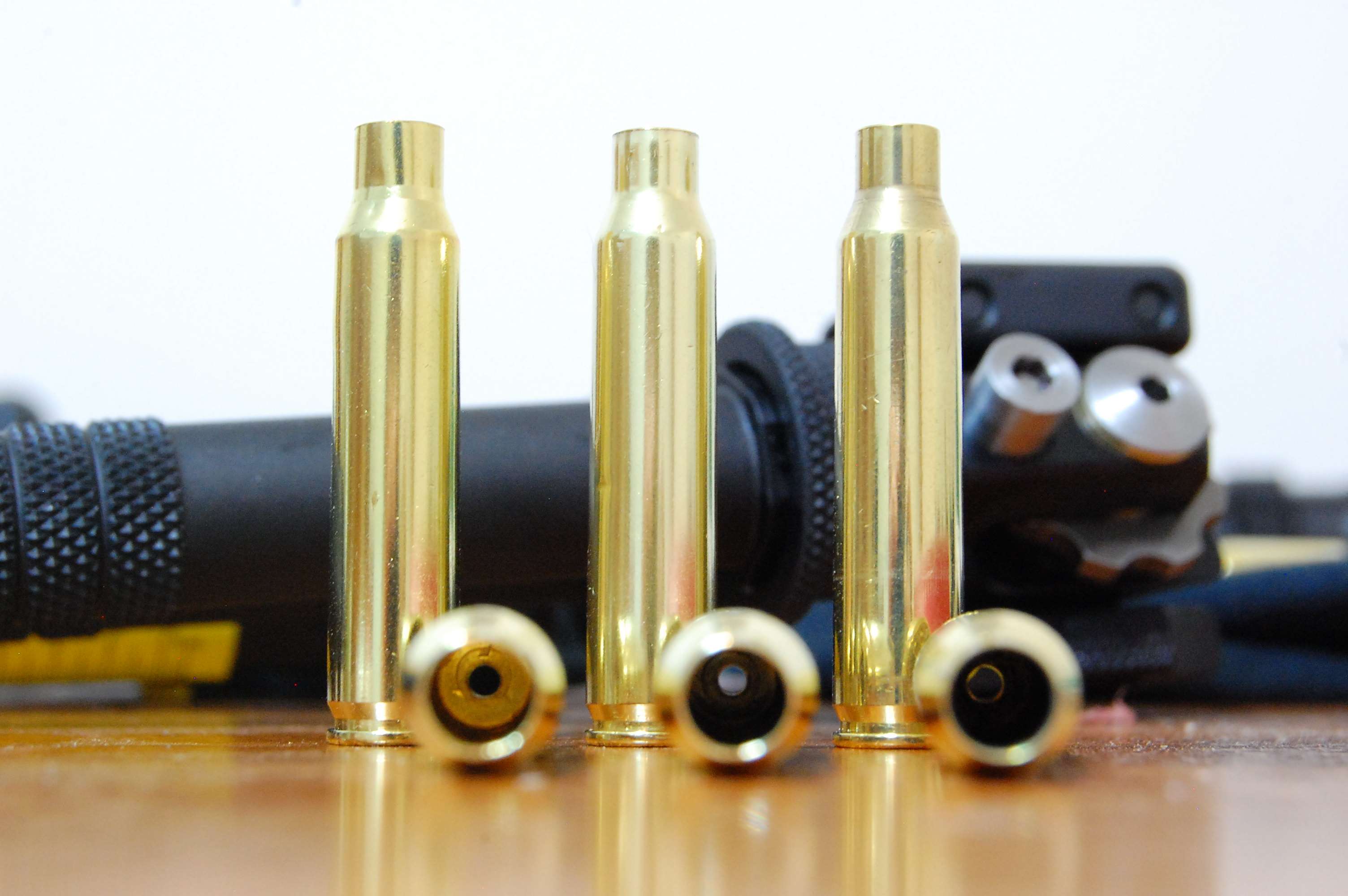
For the life of me, I can't get the insides of my .223 cases bright and shiny anymore. There's no carbon left, but for how dark the cases are on the inside, I might as well have just run these through my vibratory.... I'm pretty sure it's just very tarnished on the inside. The outside looks great.
I've tried everything I can think of, including:
-Altering Lemishine content from 1/8 teaspoon to 1.5 teaspoon
-Cold, warm, and hot water
-Clean pins by running with just soap and Lemishine
-Weighed my remaining pins since I'm a bit clumsy with pin collection (4lbs, 14oz left)
My normal solution is 1/4 teaspoon Lemishine (.40S&W case full), 1.5 tablespoons blue Dawn soap, and warm water ~1.5" from the top. I was running 100 pieces of LC .223 brass. After reloading with brass that was perfectly clean on the inside for the better half of last year, reloading with cases that are dark inside is a bit frustrating. Makes it less convenient to check powder levels, for incipient case head separation, etc.
Here's a picture of what I've got. Properly cleaned case on the left (from a few months ago), what I'm getting now in the middle (today), vibratory cleaned with corn cob on the right (about a year old). What gives? Any help would be appreciated.

Alright all you Stainless Media Experts, I need some help. I'm just about going crazy over here!
For the life of me, I can't get the insides of my .223 cases bright and shiny anymore. There's no carbon left, but for how dark the cases are on the inside, I might as well have just run these through my vibratory.... I'm pretty sure it's just very tarnished on the inside. The outside looks great.
I've tried everything I can think of, including:
-Altering Lemishine content from 1/8 teaspoon to 1.5 teaspoon
-Cold, warm, and hot water
-Clean pins by running with just soap and Lemishine
-Weighed my remaining pins since I'm a bit clumsy with pin collection (4lbs, 14oz left)
My normal solution is 1/4 teaspoon Lemishine (.40S&W case full), 1.5 tablespoons blue Dawn soap, and warm water ~1.5" from the top. I was running 100 pieces of LC .223 brass. After reloading with brass that was perfectly clean on the inside for the better half of last year, reloading with cases that are dark inside is a bit frustrating. Makes it less convenient to check powder levels, for incipient case head separation, etc.
Here's a picture of what I've got. Properly cleaned case on the left (from a few months ago), what I'm getting now in the middle (today), vibratory cleaned with corn cob on the right (about a year old). What gives? Any help would be appreciated.

I don't have any pictures but I just reached behind me to my bags of .223 brass I'm working on (some get reloaded for MILSPEC "blasting ammo" with old components including MILSURP powder, others got loaded for bolt guns and are sorted out by brand like BHA and Lapua) and at random grabbed five cases - Lake City - and another five - Winchester.
The insides all look like your picture on the left.
I follow the directions that came with the kit.
1/4 tsp Lemishine
2 tbsp Palmolive Pure and Clear (it's what I had at home and figured it should work as well as dawn)
I usually put about 200-250 cases in the tumbler for .223
Warm water to about 1-1/2 inch from the top.
Tumble for approx. 3 hours.
Just for fun, I've taken "range brass" including dozens of cases that have been ground down into the dirt, filled with mud, sun-aged and almost indistinguishable from steel case Wolf/Tula (I pass a magnet through this before I run a batch - steel cases stain the rest of the brass I've found and I wind up separating the steel cases and doing another wash cycle), and I can't tell the difference between the cases that come out of the tumbler.
This thing just f'ing works.
I DO run pistol cases through corn cob media after cleaning though. I put a tbsp of motor mica in the media as I find it lubricates the cases just enough they don't stick to the powder funnel of my Dillon press.
The batch with purified water came out much nicer than the previous batches. Looks like my tap water is incompatible with the process.... o_0
Hard water doesn't do as good of a job as soft water.
We have soft water here and I have none of the problems some guys experience.
I doubt a brita gets rid of the minerals in your water.
That said your cases are more than clean enough and no tumbler will do as well.
The carbon is gone and just staining remains.
My advice is to forget about it.
Hard water doesn't do as good of a job as soft water.
We have soft water here and I have none of the problems some guys experience.
I doubt a brita gets rid of the minerals in your water.
That said your cases are more than clean enough and no tumbler will do as well.
The carbon is gone and just staining remains.
My advice is to forget about it.
If only it were that easy.
Temp9,
Try adding a bit more Lemi Shine.
Also try adding Simple Green ( 3 tablespoons ) to the mix.
I just did an experiment that I read about, with an very old and very small (2 cup capacity) rock tumbler I had laying around.
I put 50 outdoor range brass ( previously rinsed and dried from range in warm water only) into the 2 cup drum.
I added about:
3 drops of Dawn
A light sprinkle of Lemi Shine
About 2 tablespoons of Simple Green.
Then I filled the drum with our nasty "iron range" water.
NO SS pins were added. Just brass, water and the 3 cleaners.
I let it run for about 2 hours.
Here are the results



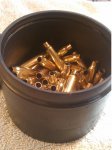
The photo of 5 each shows the "before and after" brass.
The water that I dumped out was absolutely black.
The photo of the drum with the 50 clean brass in it is just to show how much 50 .223 brass filled the drum
The total water volume capacity of this little drum is about 2 1/8 cups
The total water volume capacity of my Thumler Model B is about 21 1/2 cups.
They recommend only 2 # of brass (about 160 .223 cases)
I plan to repeat this and have the brass decapped first.
Try adding a bit more Lemi Shine.
Also try adding Simple Green ( 3 tablespoons ) to the mix.
I just did an experiment that I read about, with an very old and very small (2 cup capacity) rock tumbler I had laying around.
I put 50 outdoor range brass ( previously rinsed and dried from range in warm water only) into the 2 cup drum.
I added about:
3 drops of Dawn
A light sprinkle of Lemi Shine
About 2 tablespoons of Simple Green.
Then I filled the drum with our nasty "iron range" water.
NO SS pins were added. Just brass, water and the 3 cleaners.
I let it run for about 2 hours.
Here are the results




The photo of 5 each shows the "before and after" brass.
The water that I dumped out was absolutely black.
The photo of the drum with the 50 clean brass in it is just to show how much 50 .223 brass filled the drum
The total water volume capacity of this little drum is about 2 1/8 cups
The total water volume capacity of my Thumler Model B is about 21 1/2 cups.
They recommend only 2 # of brass (about 160 .223 cases)
I plan to repeat this and have the brass decapped first.
Last edited:
Similar threads
- Replies
- 2
- Views
- 567
